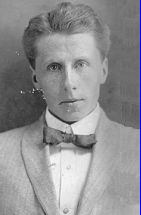 Hugh Lofting (1886-1947) was a British author, who spent much of his life in America, and is remembered for creating the children’s fantasies about Dr Doolittle, who could speak to the animals. The first, which saw its origin in the letters he wrote to his children during the Great War, was published as The Story of Doctor Dolittle, Being the History of His Peculiar Life at Home and Astonishing Adventures in Foreign Parts (New York: Frederick A. Stokes, 1920); there were to be eleven more. For a discussion of the Doolittle books, see the Encyclopedia of Science Fiction.
Hugh Lofting (1886-1947) was a British author, who spent much of his life in America, and is remembered for creating the children’s fantasies about Dr Doolittle, who could speak to the animals. The first, which saw its origin in the letters he wrote to his children during the Great War, was published as The Story of Doctor Dolittle, Being the History of His Peculiar Life at Home and Astonishing Adventures in Foreign Parts (New York: Frederick A. Stokes, 1920); there were to be eleven more. For a discussion of the Doolittle books, see the Encyclopedia of Science Fiction.
Lofting was born in Maidenhead in Berkshire, and went to school in for ten years at Mount St Mary’s in Chesterfield, Derbyshire, a Jesuit boarding-school. He had four brothers and one sister. (His eldest brother Hilary also became an engineer, and moved to Australia in 1915 after being rejected twice for military service: there he became a writer and journalist.) Hugh wanted to be a civil engineer like his brother, and spent one year (1905-1905) at the Massachusetts Institute of Technology. He completed his studies at the London Polytechnic. He worked briefly as an architect, but between 1907 and 1912 he worked in Canada (prospecting and surveying), Nigeria (the Lagos Railway) and Cuba (The Havana Railway) before settling in New York.He married there and had children (Elizabeth in 1913 and Colin in 1915) and began a writing career.
He started working for the British Ministry of Information in New York in 1915; and in 1916 he returned to England to take up a commission in the Irish Guards.
The story of the origin of Dr Doolittle, from the English village of Puddleby-on-the-Marsh, is told in his War Experiences.
His wife Flora had come over to England during the War, leaving the children with a nurse; the children came over later. They all returned to New York in 1919. I borrow the next paragraph from the Puddleby website.
British poet and novelist Cecil Roberts was on the same ship as the Loftings during their return trip to America. “Crossing the Atlantic,” Roberts later wrote, “I had a neighbour in my deck chair. Every evening about six he said he had to disappear to read a bedtime story to Doctor Dolittle. I enquired who Doctor Dolittle might be and he said it was his little son. The next day a snubnosed boy appeared on deck with his mother and thus I made the acquaintance of the original Doctor Dolittle. Later Hugh Lofting at my request showed me some of his manuscript and he wondered if it would make a book. I was at once struck by the quality of the stories and, enthusiastic about their publication, recommended him to my publisher, Mr. Stokes. I never saw Hugh Lofting again, but when his first Dolittle book came out, he sent me a copy with a charming inscription.”
The first book was published the following year, and Lofting produced one Doolittle book a year up to 1928 (with the exception of 1921), and rather less frequently after that: the last was published posthumously in 1952. He spent the rest of his life in the USA. He lived first in Connecticut, where his first wife Flora died in 1927. He remarried in 1928, and his second wife died that same year; the Doolittle books stopped coming for a while. In 1935 he married again, to a Canadian woman, Josephine Fricker, and their child Christopher was born in 1936. The family moved to California, where he spent the rest of his life: he died in Topanga, California, but was buried in Connecticut.
He published other books for children apart from the Doolittle series, and wrote one adult book, a long poem about the futility of war, published in Britain in 1912: Victory for the Slain. His Great War experiences had left him with a strong dislike of war, and he became a strong internationalist and anti-imperialist.
In 1924 he wrote an article for The Nation on “Children and Internationalism”: it was an attack on what he called “tin-soldierism”.
The boy may not have heard his father boasting of the glories of a crack regiment, but he has read a whole heap of so-called Children’s Classics in which highly painted heroes galloped, glorious and victorious, across bloody battlefields. That kind of battlefield has gone for good—it is still bloody, but you don’t gallop. And since that kind of battlefield has gone, that kind of book—for children—should go too (quoted Schmidt, 10).
My information comes partly from Gary D. Schmidt, Hugh Lofting (New York: Twayne, 1992). But the biographical information in that sometimes conflicts with the information found elsewhere (as on Wikipedia, or in the article in the Oxford Dictionary of National Biography, which is by the distinguished children’s writer Gillian Avery). There appears to be no authoritative biography, but in its absence I have assumed that Karen W. Welbourn’s Puddleby website is accurate: she says that its biographical details have been checked by Christopher Lofting.

Hi Edward, interesting stuff here. As you link to the SFE elsewhere, suggest you might here too — the entry is 1000 wds long, and deals primarily with the Dolittle books, so might be useful